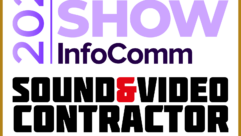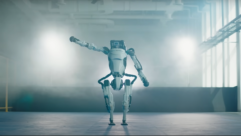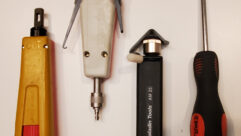LED DISPLAYS: light up the big screen
Jan 1, 2000 12:00 PM,
Peter H. Putman
Previous columns covering large-screen displays mainly focused onprojectors and monitors using emissive (CRT and plasma) technology fordirect-view monitors, and we have concentrated on transmissive (LCD) andreflective (LCD and DLP) imaging for high-brightness large screen displays.In many of these applications, the ambient lighting environment iscontrolled to maximize image contrast and legibility. That is not alwayspossible when designing and installing electronic displays in arenas andstadiums. Outdoor stadiums in particular present a lighting environmentthat can be characterized as hostile – extremely bright sunlight,pronounced shadows, variable color temperature and plenty of glare.
The new breed of arena builders are not satisfied with simpleblack-and-white dot matrix displays for player stats, animated graphics andadvertising/promotions. The typical sports fan (or concert attendee) isused to a steady diet of video and fancy visual effects, not to mentioninstant replay. For them, full-color, full-motion video is the only way togo.
How do they get there? Front projection systems are certainly bright enoughto light up 40 foot (12 m) wide screens with long projection throws butcannot produce enough contrast under daylight levels that can exceed 20,000lux. Videowalls can crank up the brightness, but they do not provide wideenough viewing angles, and their rear-screen surfaces are easily washed outin direct sunlight.
The answer is to construct an emissive display that delivers a point sourceof light bright enough to be seen more than 200 yards (183 m) away underany kind of lighting. This ideal display would be visible from viewingangles up to 160 degrees, provide full-color imaging (at least 8 bitprocessing per color channel) and have a refresh rate fast enough to showvideo. Perhaps this emissive display could also be constructed in a modularfashion for easy assembly. While we are at it, let’s try to keep the weightdown and the footprint small.
A pipe dream? Not really. Using nothing more than the garden-variety lightemitting diode (LED), a switching matrix and a lot of wiring, SACOSmartvision of Montreal has been assembling some pretty impressivedirect-view displays for indoor and outdoor venues, among them theOakland-Alameda County Coliseum, the MCI Center in Washington, D.C., andPSI Net Stadium in Baltimore, home of the Baltimore Ravens football team.
The LED display concept is not new. LEDs have been used for crude,low-resolution signboards for years, and they have also been put to work inmatrix configurations for numeric and character displays. The reason theywork well in large screens has to do with our perception of imageresolution. If you have a magnifying glass handy, hold it over anadvertisement or photograph in this magazine. You will see thousands ofcolored dots or pixels, which make up the screen of the photograph. Atclose range, these dots are quite noticeable, but at normal viewingdistances, you do not see the dots, just the image that they form.
LED displays work exactly the same way. Viewed up close, they are a jumbleof red, green and blue dots. As you back away from the display, the dotsbecome less noticeable. Eventually, your eyes stop paying attention to thedisplay structure and concentrate instead on the images being formed.Depending on how coarse or fine the matrix of LEDs, this distance will varyfrom tens to hundreds of feet.
SACO’s Smartvision screens are manufactured in a variety of screenresolutions, primarily determined by the effective pixel pitch. In a CRTdisplay, that pitch is determined by the spot size of the electron gun asit traces a raster and is typically less than 1 mm. Plasma displays canhave slightly large pixels close to 1 mm, while such matrix displays asLCDs and DMDs are considerably smaller and are measured in nanometers.
In contrast, the smallest pixel configuration in a Smartvision displaymeasures 4 mm, about 225infinity larger than a single pixel in a 0.7 inch(18 mm) diagonal SVGA LCD panel. The largest pixel matrix for an indoorSmartvision screen is 15 mm, while the largest available for an outdoorscreen is 40 mm. Obviously, these screens were designed for viewing at longdistances. SACO’s recommended minimum viewing distance for a 4 mm pitcharray is 10 feet (3 mm), while the 30 mm and 40 mm arrays are specified fora 100 foot (30 m) viewing distance.
Using custom interfaces and driver boards, the individual pixel matrixesare driven in a progressive-scan configuration. This allows the display ofboth line-doubled video and computer graphics at a 60 Hz refresh rate.
How bright of an image will you see? SACO claims up to 2,500 candelas/msuperscript 2 for its indoor displays and between 5,000 candelas/msuperscript 2 and 6,000 candelas/m superscript 2 for the outdoor versions.Ambient light levels indoors are more easily controlled, and it is easy toobtain high contrast from such a display; there is little light spilling onthe screen surface that will reduce contrast.
Outdoors, however, things are different. As I write this article, it israining outside, and the sky is a dark, overcast gray. Even so, a quicklight reading shows that I still have more than 1,760 candelas/msuperscript 2 of daylight to contend with, which would reduce imagecontrast to 2.8:1 using a 5,000 candelas/m superscript 2 Smartvision LEDarray. So, another trick is used to kick up contrast – small horizontallouvers that line the top of each Smartvision four-pixel array. This louvercan reduce stray light levels by a factor of eight or more, boosting imagecontrast by a corresponding amount.
The secret to making these displays work was the discovery of a bright blueLED, a process that has stumped engineers for many years. There issomething about the color blue that has also vexed scientists in lasertechnology. In a typical Smartvision outdoor pixel matrix, four individualfive-LED arrays contain eight red LEDs, eight green LEDs and four blueLEDs. The red and green LEDs surround the blue LEDs and the effect lookslike four dice rolled to show fives.
SACO claims 150,000 hours for each LED with a brightness fall-off of only15% after 100,000 hours of operation. It is possible to get even moreillumination from LEDs, but at an accelerated aging cycle. Maximum viewingangles are specified at 170 degrees and 90 degrees vertically.
There is a phenomenon to LED displays, known as shouldering, that willaffect normal viewing. Shouldering is caused by mutual obstruction amongadjacent LEDs, creating noticeable color shifts. For example, if you arepositioned at increasingly acute viewing angles from an outdoor screenusing the 4infinity1 matrix, you will notice more red and green in theimage and less blue as many of the blue LEDs are partially blocked fromview.
I traveled to two different arenas to check out a couple of Smartvisionscreens recently, both installed by Professional Products of Maryland. Thefirst installation is part of a scoreboard in the brand-new Sovereign BankArena in Trenton, NJ. This 8,000 seat venue (10,000 for concerts) hostsboth minor league hockey and basketball games, and uses four 79infinity99(2.1 m infinity 2.7 m) arrays of Smartvision panels for video replays,advertisements, promotions and special video graphics. The screens in thisarena are the brightest thing you see in the arena, even more so than thespotlights on the ice.
Each panel is made up of a 16 infinity 16 LED matrix containing 256 red,green and blue LEDs, and there are 99 panels per screen (11 horizontal rowsand nine vertical rows). The effective pixel resolution of each activedisplay is 2,816 infinity 2,304 sets of red, green and blue LEDs. SACO uses10 bit 4:2:2 component signal processing or 1,024 colors per red, green andblue channel. The interface is all digital and conforms to SMPTE 259M andCCIR-601 using single coaxial cables for signal distribution.
Laura Black, the technical services coordinator for Sovereign Bank Arena,uses a variety of formats to feed video and graphics to the hanging videoboard, including Sony DVCAM and VHS videotape playback. A Media 100workstation is used for editing and special graphics effects, and a varietyof Videotek DDRs and framestores are available for replays and still shots.Up to nine cameras can be handled through a Ross RVS210A switcher, and aPinnacle Deko 500 system provides real-time video SFX.
About 100 miles (161 km) to the south, the staff at the Baltimore Ravensfacility have configured a unique Smartvision screen into their ownproprietary game-day video system they call “Raven Image”. The pair of LEDdisplays sit at opposite ends of PSINet Stadium and measure 100 feet wideby 25 feet high (30 m infinity 7.6 m) with a viewable area of969infinity249 (29 m infinity 7.3 m). Unlike other stadiums whereelectronic displays are mounted high about the nosebleed seats, these twoscreens sit nicely between the first and second levels of the stadium,providing a more natural sightline.
Both screens use the 30 mm outdoor 4infinity1 pixel array and are actuallymade up of two complete 489infinity249 (14.6 m infinity 7.3 m) screens thatare precisely aligned to provide a 4:1 panoramic image. As a result, thereare four remote controls setting up and calibrating the two screens. Allvideo and graphics originate in a sophisticated production studio thattakes 15 people to operate during a game. All images are captured, editedand manipulated as 16:9 525-line video in the studio then effectivelycropped by the long, narrow Smartvision screen.
According to producer/director Marcia Kapustin, no other professionalsports team uses such an unusual production and display format, which sheconsiders ideal for the perspective of a football game. What is even moreinteresting is that Raven Image runs continuously during a game, just likea network broadcast. In fact, the Raven Image crew will sometimes takecamera feeds from CBS NFL telecasts and mix them with its own 16:9widescreen coverage.
The control room at PSINet Stadium includes a full-bore Sony DVS-7250digital switcher with a raft of Ikegami cameras set up with 16:9 monitorsfor acquisition and three Tektronix PDR200 Profile disc recorders/playerswith 12 channels of video for instant replay and video segments. Up to 10cameras can be sourced, and several Type DeKo and Pinnacle DVExtreme boxesare online for special effects. Four DPS 465 frame synchronizers feed eachof the four individual screens, and Panorama aspect ratio converters can beused to resize 4:3 material to the 16:9 format.
During my visit, the sun moved in and out of cloud cover and completelyilluminated the west screen. Despite this much ambient light, there wasenough contrast (about 10:1) in the image to clearly see the clips of anearlier game. No doubt, the louvers helped because the full daylight levelswould have been far in excess of 5,000 candelas/m superscript 2 (low haze,direct sunlight). Of course, both screens are in the field of view of atleast 75% of the spectators, so there is always one screen that is fullylegible.










